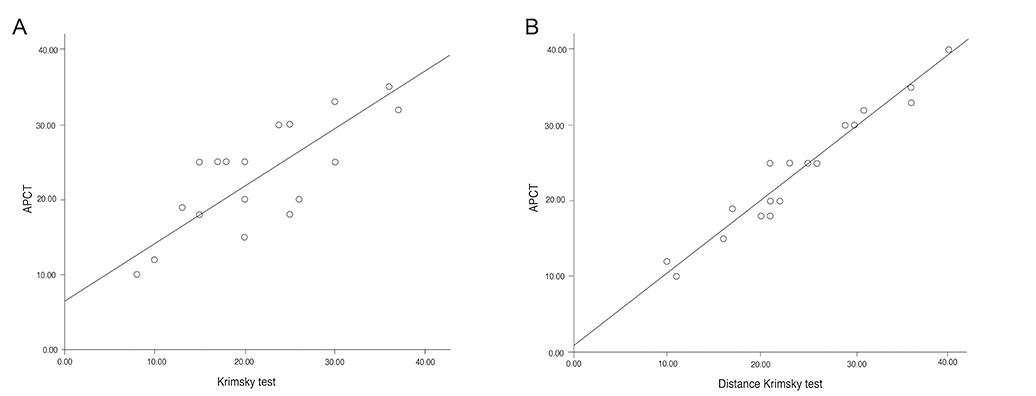Korean J Ophthalmol.
2013 Aug;27(4):276-281. 10.3341/kjo.2013.27.4.276.
Measurement of Strabismic Angle Using the Distance Krimsky Test
- Affiliations
-
- 1Department of Ophthalmology, Chung-Ang University Hospital, Seoul, Korea. njmoon@chol.com
- 2Laboratory of Disease Functional Genomics, Graduate School of Medical Science and Engineering, KAIST, Daejeon, Korea.
- KMID: 1705424
- DOI: http://doi.org/10.3341/kjo.2013.27.4.276
Abstract
- PURPOSE
To evaluate the correlation of the distance Krimsky test and the alternate prism cover test (APCT) for the distance deviation in patients with horizontal strabismus.
METHODS
Forty patients with horizontal strabismus (20 esotropia and 20 exotropia) were included in this study. Patients with a variable angle of deviation, vertical angle over 5 prism diopters, impaired binocular vision, or poor cooperation were excluded. We instructed the patient to look a target 6 meters away, and applied a prism over the patient's dominant eye while flashing a light source 33 centimeters from the middle of both eyebrows. When the corneal light reflexes were located on the center of each cornea, we measured the angle of deviation. We defined this method as 'distance Krimsky test,' and the angle measured by this method was compared with the conventional Krimsky test and APCT at distance. We analyzed the accuracy and intra- and inter-observer reliability.
RESULTS
The angle of strabismus measured by the distance Krimsky test showed a significant agreement and correlation with the deviation angle measured by the APCT. We elicited the correlation gradient between the angle measured by the distance Krimsky test and the APCT. In addition, the distance Krimsky test showed significant intra- and inter-observer reliabilities.
CONCLUSIONS
The distance Krimsky test is expected to be more useful than the Krimsky test in measuring the distance angle of deviation for patients with strabismus in whom it is difficult to measure the angle of deviation using the APCT. The distance Krimsky test can be an accurate and useful test through the improvement of proficiency of examiners and the establishment of individualized normative data.
Keyword
MeSH Terms
Figure
Reference
-
1. Von Noorden GK, Campos EC. Examination of patient-II: motor signs in heterophoria and heterotropia. In : Von Noorden GK, Campos EC, editors. Binocular vision and ocular motility: theory and management of strabismus. 6th ed. St. Louis: Mosby;2002. p. 85–100. p. 168–210.2. Lee JA, Lee HY. New method for measurement of strabismic angle using corneal reflex and photograph. J Korean Ophthalmol Soc. 2002; 43:1988–1992.3. Choi RY, Kushner BJ. The accuracy of experienced strabismologists using the Hirschberg and Krimsky tests. Ophthalmology. 1998; 105:1301–1306.4. Cho YA, Roh KH. Early surgery for infantile esotropia. J Korean Ophthalmol Soc. 1993; 34:1251–1256.5. Parks MM. Symposium: infantile esotropia: summary and conclusions. Am Orthopt J. 1968; 18:19–22.6. Ing MR. Early surgical alignment for congenital esotropia. Ophthalmology. 1983; 90:132–135.7. Zak TA, Morin JD. Early surgery for infantile esotropia: results and influence of age upon results. Can J Ophthalmol. 1982; 17:213–218.8. Thompson JT, Guyton DL. Ophthalmic prisms: measurement errors and how to minimize them. Ophthalmology. 1983; 90:204–210.9. Wright KW. The ocular motor examination. In : Wright KW, Spiegel PH, editors. Pediatric ophthalmology and strabismus. 2nd ed. New York: Springer;2003. p. 189–203.10. Yang HK, Han SB, Hwang JM, et al. Assessment of binocular alignment using the three-dimensional Strabismus Photo Analyzer. Br J Ophthalmol. 2012; 96:78–82.11. Von Noorden GK, Helveston EM. Decentered corneal light reflex. In : Von Noorden GK, Helveston EM, editors. Strabismus: a decision making approach. St. Louis: Mosby;1994. p. 26–27.
- Full Text Links
- Actions
-
Cited
- CITED
-
- Close
- Share
- Similar articles
-
- New Method for Measurement of Strabismic Angle using Corneal Reflex and Photograph
- Digitalized Videographic Measurement of Strabismic Angle
- Surgical Outcomes of Intermittent Exotropia as a Function of Strabismic Angle
- Analysis about Diffe rences of Preoperative Measurement of Strabismic Angle in Exodeviation
- Sensory Testing for Binocular Suppression in Accommodative Esotropes




